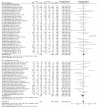Reconsidering the Tolerable Upper Levels of Zinc Intake among Infants and Young Children: A Systematic Review of the Available Evidence
- PMID: 35565906
- PMCID: PMC9102402
- DOI: 10.3390/nu14091938
Reconsidering the Tolerable Upper Levels of Zinc Intake among Infants and Young Children: A Systematic Review of the Available Evidence
Abstract
Safe upper levels (UL) of zinc intake for children were established based on either (1) limited data from just one study among children or (2) extrapolations from studies in adults. Resulting ULs are less than amounts of zinc consumed by children in many studies that reported benefits of zinc interventions, and usual dietary zinc intakes often exceed the UL, with no apparent adverse effects. Therefore, existing ULs may be too low. We conducted a systematic bibliographic review of studies among preadolescent children, in which (1) additional zinc was provided vs. no additional zinc provided, and (2) the effect of zinc on serum or plasma copper, ceruloplasmin, ferritin, transferrin receptor, lipids, or hemoglobin or erythrocyte super-oxide dismutase were assessed. We extracted data from 44 relevant studies with 141 comparisons. Meta-analyses found no significant overall effect of providing additional zinc, except for a significant negative effect on ferritin (p = 0.001), albeit not consistent in relation to the zinc dose. Interpretation is complicated by the significant heterogeneity of results and uncertainties regarding the physiological and clinical significance of outcomes. Current zinc ULs should be reassessed and potentially revised using data now available for preadolescent children and considering challenges regarding interpretation of results.
Keywords: review; upper-intake levels; zinc; zinc fortification; zinc nutrient reference values (NRVs); zinc supplementation.
Conflict of interest statement
The authors declare no conflict of interest.
Figures




Similar articles
-
Pulp treatment for extensive decay in primary teeth.Cochrane Database Syst Rev. 2018 May 31;5(5):CD003220. doi: 10.1002/14651858.CD003220.pub3. Cochrane Database Syst Rev. 2018. PMID: 29852056 Free PMC article.
-
Folate supplementation in people with sickle cell disease.Cochrane Database Syst Rev. 2018 Mar 16;3(3):CD011130. doi: 10.1002/14651858.CD011130.pub3. Cochrane Database Syst Rev. 2018. PMID: 29546732 Free PMC article.
-
Comparison of the effectiveness of inhaler devices in asthma and chronic obstructive airways disease: a systematic review of the literature.Health Technol Assess. 2001;5(26):1-149. doi: 10.3310/hta5260. Health Technol Assess. 2001. PMID: 11701099
-
Nutrition-specific interventions for preventing and controlling anaemia throughout the life cycle: an overview of systematic reviews.Cochrane Database Syst Rev. 2021 Sep 26;9(9):CD013092. doi: 10.1002/14651858.CD013092.pub2. Cochrane Database Syst Rev. 2021. PMID: 34564844 Free PMC article.
-
Heliox for croup in children.Cochrane Database Syst Rev. 2021 Aug 16;8(8):CD006822. doi: 10.1002/14651858.CD006822.pub6. Cochrane Database Syst Rev. 2021. PMID: 34397099 Free PMC article.
Cited by
-
Tracing Zinc's Role in Preterm Infants' Health: A Narrative Review.Adv Nutr. 2024 Dec;15(12):100295. doi: 10.1016/j.advnut.2024.100295. Epub 2024 Nov 8. Adv Nutr. 2024. PMID: 39675840 Free PMC article. Review.
-
Zinc Fortification: Current Trends and Strategies.Nutrients. 2022 Sep 21;14(19):3895. doi: 10.3390/nu14193895. Nutrients. 2022. PMID: 36235548 Free PMC article. Review.
-
Dietary supplements increase the risk of excessive micronutrient intakes in Danish children.Eur J Nutr. 2023 Sep;62(6):2449-2462. doi: 10.1007/s00394-023-03153-5. Epub 2023 May 1. Eur J Nutr. 2023. PMID: 37127694 Free PMC article.
-
Estimating food consumption, micronutrient intake and the contribution of large-scale food fortification to micronutrient adequacy in Tanzania.Public Health Nutr. 2024 Nov 11;27(1):e230. doi: 10.1017/S136898002400199X. Public Health Nutr. 2024. PMID: 39526477 Free PMC article.
-
Current and potential contributions of large-scale food fortification to meeting micronutrient requirements in Senegal: a modelling study using household food consumption data.BMJ Public Health. 2024 Jul;2(2):e001221. doi: 10.1136/bmjph-2024-001221. Epub 2024 Nov 8. BMJ Public Health. 2024. PMID: 39822945 Free PMC article.
References
-
- International Zinc Nutrition Consultative Group (IZiNCG) Brown K.H., Rivera J.A., Bhutta Z., Gibson R.S., King J.C., Lonnerdal B., Ruel M.T., Sandtrom B., Wasantwisut E., et al. International Zinc Nutrition Consultative Group (IZiNCG) technical document #1. Assessment of the risk of zinc deficiency in populations and options for its control. Food Nutr. Bull. 2004;25:S99–S203. - PubMed
-
- Institute of Medicine (USA) Panel on Micronutrients . Dietary Reference Intakes for Vitamin A, Vitamin K, Arsenic, Boron, Chromium, Copper, Iodine, Iron, Manganese, Molybdenum, Nickel, Silicon, Vanadium, and Zinc. Institute of Medicine; Washington, DC, USA: 2001. - PubMed
-
- World Health Organization (WHO) Food and Agricultural Organization of the United Nations (FAO) Vitamin and Mineral Requirements in Human Nutrition. 2nd ed. World Health Organization; Geneva, Switzerland: 2004. pp. 1–341.
-
- Scientific Committee on Food. Scientific Panel on Dietetic Products Nutrition and Allergies . Tolerable Upper Intake Levels for Vitamins and Minerals. European Food Safety Authority (EFSA); Parma, Italy: 2006.
-
- Institute of Medicine (USA) Food and Nutrition Board . Dietary Reference Intakes: A Risk Assessment Model for Establishing Upper Intake Levels for Nutrients. National Academies Press; Washington, DC, USA: 1998. - PubMed

